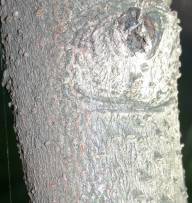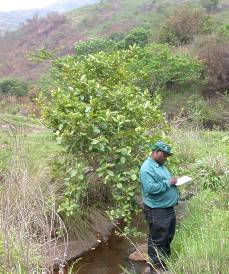Maesa lanceolata
Maesa lanceolata Forssk.
Family: Maesaceae
Common names: false assegai ( Eng. ); valsassegaai (Afr.); umalunguzalazikhakhona, inhlavubele, umaguqu, isidenda, ubhoqobhoqo (Zulu); intendekwane (Xhosa); ligucu, umbohlobohlo (Sw); muunguri ( Venda )
SA Tree No: 577
Introduction
An apple-green tree-shrub gives shade to a cool, inviting stream: this idyllic prospect is repeated a million times in KwaZulu-Natal , South Africa 's garden province. All too often the shade turns out to be from an invasive willow, but here is a charming indigenous alternative.

Description
Description
Maesa lanceolata is a very variable species as it can be a straggling shrub, 2 to 3 m tall, or a small tree with a single stem up to 9 m tall, or a rounded bushy tree with branches almost at ground level. Leaves spirally arranged, lance-shaped, 40-180 x 25-130 mm, tapering to pointed tips, sometimes with blunt or rounded tips, simple, pale or dark green, with toothed margins. The midrib and lateral veins are conspicuously raised below. Sometimes the leaves are large and thick and resemble those of Curtisia dentata , the assegai, and people often mistake them, but the leaves of C. dentata are opposite, not alternate, as those of the false assegai are.

The bark is usually smooth and brown. Flowers are minute, bisexual, sweetly scented, white or yellow, in many-flowered sprays in the axils of leaves and at the ends of branches. Flowering in spring (peak in October in KwaZulu-Natal ) but it has been observed flowering on and off throughout the year. Matured fruit are usually found in March, usually crowded in dense sprays, are creamy-white, edible berries that have remnants of calyx lobes at the top, 3-6 mm in diameter.
Distribution and habitat
Distribution description
Although false assegai usually grows on streambanks, it can also be found on cliff tops, in both midland and coastal areas. On a recent expedition, the authors of this note were informed that our base camp was in a place that expects significant snowfalls once in eight years. As we saw false assegai thriving in several localities the next day, we deduce that it can withstand at least moderate frost, but as it is usually a waterside or mistbelt resident, it evidently needs a plentiful and constant supply of moisture. It is found from the coast to about 1 500 m above sea level. In these habitats it is found throughout the eastern part of Africa from the former Transkei northwards to Arabia, and across to India.
Derivation of name and historical aspects
History
The generic name is derived from the Arabic name maas for this species. This reminds us that the first botanist to write about the tree was Pehr Forsskal, who encountered it on his travels in what is now Yemen . The specific epithet lanceolata refers to the lance-shaped leaves (pointed, and widest below the middle). The meaning of one of its isiZulu names, umalunguzalazikhakhona, refers to one of its habitats which is adjacent to clear streams or rivers. This is where young girls would draw water and young men will would peep at them through the leaves, (lunguza, peep; lapho , where; zikha , they draw water; khona , there). This name may also be translated as 'he who peeps where they draw water', and refers to the common habitat of the tree, hanging over clear streams. Our picture shows the second apparently booking a tree in just this position for being a Peeping Tom.

The genus Maesa includes about 100 species, and is found mainly in the Old World tropics, with outliers as far afield as Japan and Australia . Apart from the present species, one other, M. indica (Roxb.) Sweet, from India, is known to have horticultural value.

Ecology
Ecology
Although the fruits of this tree are poisonous to humans and other mammals, they are eaten by birds. Plants are therefore bird-dispersed. The white, sweetly scented flowers are typical of those which are pollinated by night-flying insects such as moths. It seems reasonable to assume that they are pollinated by small moths.
Uses and cultural aspects: Ground-up fruits in milk are given to a child at night as a treatment for ringworm. The roots are used for steaming and as a purgative to remove pimples. In some parts of Zululand , when a girl is getting married, her family selects a suitable shrub of umalunguzalazikhakhona for her. On the eve of her wedding, she takes her final bath at home before she leave for the groom's home. She takes this bath in the bushy shrub while doing this she rubs herself against the leaves of this plant. After this bath she does not put on any clothing but wraps herself in with a blanket and then her father leads her to the groom's home. Bathing in this shrub will take away all the curses that may have been cast on her marriage.
Growing Maesa lanceolata
Grow
Gardeners with a stream or pond to work with are fortunate in that they have the ideal place to grow this tree . Put it in a place where it hangs over the water, and note where the shade falls. This is a good place for a lawn of shade-tolerant grass or possibly a paved area, where one can sit and enjoy the beauty of the garden. Unlike riverside willows, for which it would serve as a direct replacement, it is not invasive, and the berries will attract birds to the garden (but probably not while the gardener and other humans are nearby).
False assegai reportedly grows easily from seed. Once it has germinated it tends to produce too many branches, hence becoming untidy. It does very well in eroded areas by binding the soil, and here it should be re-introduced. The tree in the Kwazulu-Natal Herbarium grounds has not been harmed by judicious pruning, and seems to be remarkably free from pests and diseases.
References
- Glen, H.F. 2004. SAPPI What's in a name? Jacana, Johannesburg .
- Mabberley, D.J. 1997. The plant-book , edn 2. Cambridge University Press, Cambridge .
- Ngwenya, M.A., Koopman, A. & Williams, R. 2003. Ulwazi LwamaZulu Ngezimila: isingeniso/Zulu botanical knowledge: an introduction . KwaZulu-Natal Herbarium, National Botanical Institute, Durban .
- Palmer, E. & Pitman, N. 1972. Trees of southern Africa . Balkema, Cape Town .
- Pooley, E.S. 1993. The complete field guide to trees of Natal, Zululand and Transkei . Natal Flora Publications Trust, Durban .
Credits
Hugh Glen & Mkhipheni Ngwenya
KwaZulu-Natal Herbarium
February 2005
Plant Attributes:
Plant Type: Shrub, Tree
SA Distribution: Eastern Cape, KwaZulu-Natal, Limpopo, Mpumalanga
Soil type: Loam
Flowering season: Early Summer
PH: Acid, Neutral
Flower colour: White
Aspect: Full Sun
Gardening skill: Easy
Special Features:
Horticultural zones









Rate this article
Article well written and informative
Rate this plant
Is this an interesting plant?
Login to add your Comment
Back to topNot registered yet? Click here to register.